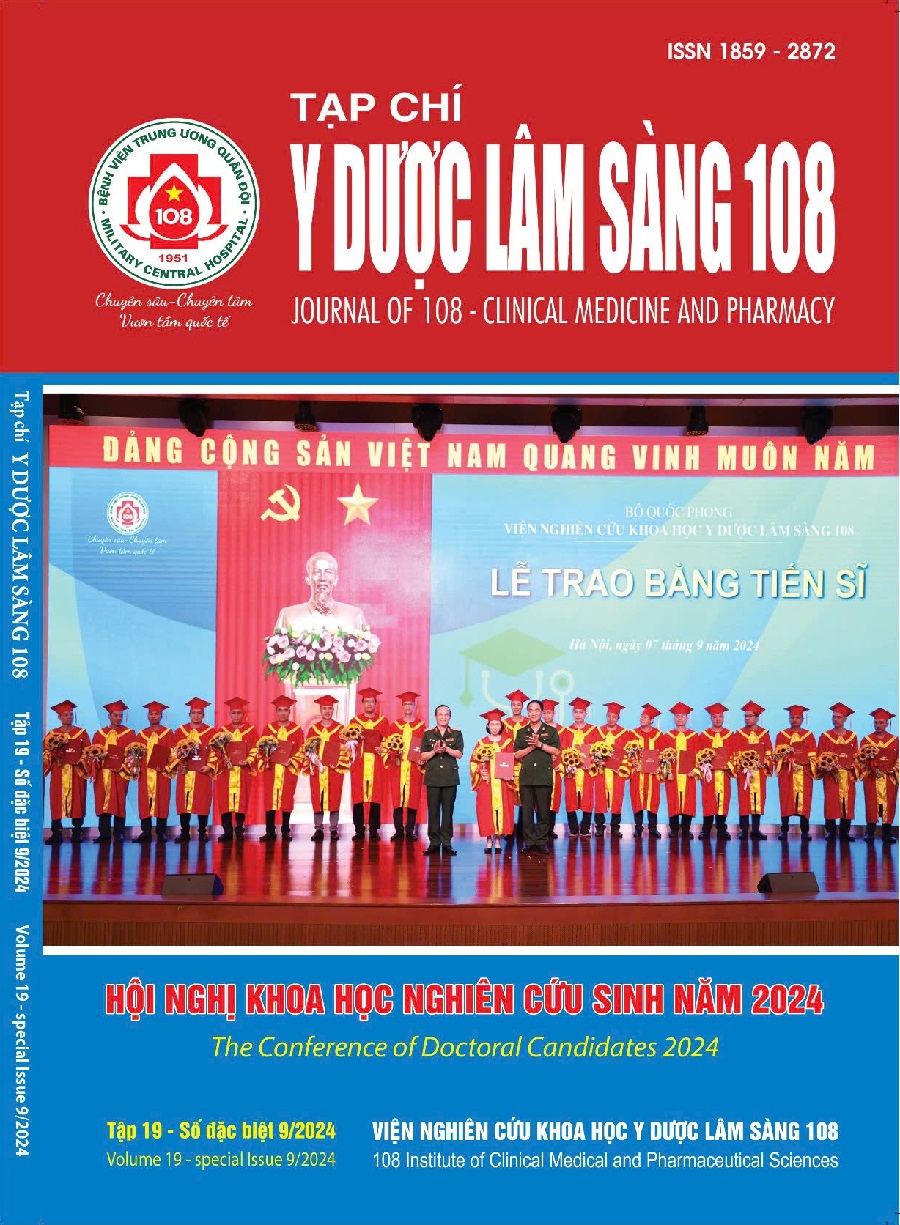Đánh giá bước đầu hiệu quả và tính an toàn can thiệp cấp cứu đặt stent chuyển hướng dòng chảy kết hợp nút coil điều trị phình mạch máu não vỡ tại Bệnh viện Trung ương Quân đội 108
Main Article Content
Keywords
Tóm tắt
Mục tiêu: Đánh giá đặc điểm hình thái tổn thương phình mạch máu não vỡ và tính hiệu quả, an toàn của phương pháp điều trị bằng stent chuyển hướng dòng chảy kết hợp nút coils cấp cứu. Đối tượng và phương pháp: Nghiên cứu hồi cứu trên 16 bệnh nhân với 16 tổn thương phình mạch là nguyên nhân vỡ gây chảy máu dưới nhện được điều trị bằng stent chuyển hướng dòng chảy và coils từ tháng 01 năm 2022 đến tháng 5 năm 2024. Kết quả: Phình mạch dạng túi chiếm 43,75%, dạng phỏng nước 50,00% và dạng hình thoi chiếm 6,25%. Kích thước tổn thương phình mạch trung bình 6,17 ± 5,21mm với tỉ lệ thân túi trên cổ túi < 1,5 chiếm 50,00%. Vị trí phình mạch thuộc tuần hoàn trước chiếm 87,50%. Kỹ thuật đặt stent chuyển hướng dòng chảy kết hợp nút coils được thực hiện thành công cho 100% bệnh nhân. Ngay sau can thiệp, 56,25% phình mạch được gây tắc hoàn toàn và 100% phình mạch được tắc hoàn toàn sau 1 tháng. Không ghi nhận biến chứng do kỹ thuật, tỉ lệ biến chứng chung 12,5%. Có 1 bệnh nhân tử vong do vỡ tái phát ngay sau can thiệp, chiếm 6,25%. Sau 1 tháng, các bệnh nhân sống sót gần như phục hồi hoàn toàn với mRS = 0 chiếm 14/15 bệnh nhân, có 1 bệnh nhân có di chứng nhẹ sau 3 tháng với mRS = 1. Kết luận: Can thiệp cấp cứu đặt stent chuyển hướng dòng chảy kết hợp nút coil điều trị phình mạch máu não vỡ có tính an toàn và hiệu quả cao.
Article Details
Các tài liệu tham khảo
2. Raymond J, Klink R, Chagnon M, Barnwell SL, Evans AJ, Mocco J, Hoh BH, Turk AS, Turner RD, Desal H, Fiorella D, Bracard S, Weill A, Guilbert F, Lanthier S, Fox AJ, Darsaut TE, White PM, Roy D (2017) Hydrogel versus Bare platinum coils in patients with large or recurrent aneurysms prone to recurrence after endovascular treatment: A randomized controlled trial. AJNR Am J Neuroradiol 38(3): 432-441.
3. Natarajan SK, Shallwani H, Fennell VS, Beecher JS, Shakir HJ, Davies JM, Snyder KV, Siddiqui AH, Levy EI (2017) Flow diversion after aneurysmal subarachnoid hemorrhage. Neurosurg Clin N Am 28(3): 375-388.
4. Cagnazzo F, di Carlo DT, Cappucci M, Lefevre PH, Costalat V, Perrini P (2018) Acutely ruptured intracranial aneurysms treated with flow-diverter stents: A systematic review and meta-analysis. AJNR Am J Neuroradiol 39(9): 1669-1675.
5. Mascitelli JR, Moyle H, Oermann EK, Polykarpou MF, Patel AA, Doshi AH, Gologorsky Y, Bederson JB, Patel AB (2015) An update to the Raymond-Roy Occlusion Classification of intracranial aneurysms treated with coil embolization. J Neurointerv Surg 7(7): 496-502.
6. Jersey AM and Foster DM (2024) Cerebral Aneurysm, in StatPearls. 2024: Treasure Island (FL) ineligible companies. Disclosure: David Foster declares no relevant financial relationships with ineligible companies.
7. Abe M, Tabuchi K, Yokoyama H, Uchino A (1998) Blood blisterlike aneurysms of the internal carotid artery. J Neurosurg 89(3): 419-424.
8. Kalani MY, Zabramski JM, Kim LJ, Chowdhry SA, Mendes GA, Nakaji P, McDougall CG, Albuquerque FC, Spetzler RF (2013) Long-term follow-up of blister aneurysms of the internal carotid artery. Neurosurgery 73(6): 1026-1033; discussion 1033.
9. Sebastian Sanchez M, Meredith Hickerson, Rishi R Patel, Dana Ghazaleh, Ranita Tarchand, Geeta S. Paranjape, Holly Pope, Santiago Ortega‐Gutierrez, John M Pederson, David Hasan, Madhavan L Raghavan, and Edgar A Samaniego (2023) Morphological characteristics of ruptured brain aneurysms: A systematic literature review and meta‐analysis. Stroke: Vascular and Interventional Neurology.
10. Agarwal A, Gokhale S, Gupta J, Raju R, Nimjee S, Smith T, Britz GW (2014) Use of pipeline flow diverting stents for wide neck intracranial aneurysms: A retrospective institutional review. Asian J Neurosurg 9(1): 3-6.
11. Foreman PM, Ilyas A, Cress MC, Vachhani JA, Hirschl RA, Agee B, Griessenauer CJ (2021) Ruptured intracranial aneurysms treated with the pipeline embolization device: A systematic review and pooled analysis of individual patient data. AJNR Am J Neuroradiol 42(4): 720-725.
12. Guimaraens L, Vivas E, Saldaña J, Llibre JC, Gil A, Balaguer E, Rodríguez-Campello A, Cuadrado-Godia E, Ois A (2020) Efficacy and safety of the dual-layer flow-diverting stent (FRED) for the treatment of intracranial aneurysms. J Neurointerv Surg 12(5): 521-525.
13. Zhong W, Kuang H, Zhang P, Yang X, Luo B, Maimaitili A, Zhao Y, Song D, Guan S, Zhang H, Wang Y, Wang D, Su W, Wang Y (2021) Pipeline embolization device for the treatment of ruptured intracerebral aneurysms: A multicenter retrospective study. Front Neurol 12: 675917.
14. Cohen JE, Gomori JM, Moscovici S, Kaye AH, Shoshan Y, Spektor S, Leker RR (2021) Flow-diverter stents in the early management of acutely ruptured brain aneurysms: Effective rebleeding protection with low thromboembolic complications. J Neurosurg: 1-8.
 ISSN: 1859 - 2872
ISSN: 1859 - 2872
